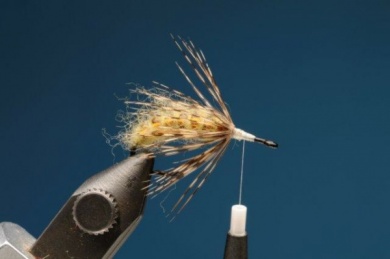Small pearly glass beads can be used creatively to tie many different flies. These give us a chance to experiment with transparency, iridescence and density of our flies. Fly tiers willing to try new things will find that these materials create new effects that are hard to achieve by using other mat Ver más...Small pearly glass beads can be used creatively to tie many different flies. These give us a chance to experiment with transparency, iridescence and density of our flies. Fly tiers willing to try new things will find that these materials create new effects that are hard to achieve by using other materials separately.These pearls were already used for streamers in the 40s, sometimes placed on the leader. Nowadays, we find them in midge larvae or chironomid imitations. I had great results for years using them for Soft Hackle bodies and for caddis larvae and pupae like this M.M. Translucent Pupa, that has a realistic look, good transparency and segmentation; making it really effective.These beads are also great for bonefish flies, streamers, all kinds of nymphs, shrimp, and mostly all flies, even dries and emergers. Just give them a try and let creativity lead you to new paths in fly tying.
Deslice el cursor sobre la imagen para visualizar la mosca con zoom.
Deslice el dedo sobre la imagen para hacer zoom.

Listado de materiales
MaterialsThread: 8/0, white.Hook: Partridge K12ST, Daiichi 1150, Mustad C49S or similar; sizes 8 to 16.Beads: mid brown color (I use browns and greens).Abdomen dubbing: Stalcup Micro Fine Dry Fly Dubbing.Hackle: dark Hungarian partridge feather.Immature wings: hen feather tips, mid or dark Blue Dun color.Thorax dubbing: hare´s ear or Davy Wotton Squirrel Dubbing.
Pasos
Paso 1
Press the barb of the hook to slide the bead. Thread the abdomen. Set the beads firmly with some thread so these don´t move. Use the vise to lock them tightly on the other side.
Paso 2
Tie and cut the thread at the front. Lock the beads at the back with thread. Leave some space between the beads so some dubbing fits in later.
Paso 3
Thread some ultra fine dubbing and carefully place it between the beads.
Paso 4
No additional weighing is needed with these beads.
Paso 5
Use a wire brush to softly take some hair out so the fly has a halo, an important aspect in pupae.
Paso 6
Tie the Hungarian partridge feather hackle with 2 or 3 turns so the abdomen isn’t covered and doesn’t lose its leg moves.
Paso 7
Prepare the two hen feathers. These should be a bit shorter than the abdomen.
Paso 8
Tie the two feathers, these should remain flat at the sides of the abdomen, slightly pointing down. Shape the thorax with two turns of dubbing (hare´s ear or Davy Wotton Squirrel Dubbing, Antron on this one adds more transparency).
Paso 9
Tie the finish knot. Use permanent marker to paint the head brown. Loosen some thorax hair with the brush so as to give life to the fly in the water.
Paso 10
M.M. Translucent Pupa is now ready for an unforgettable afternoon.










